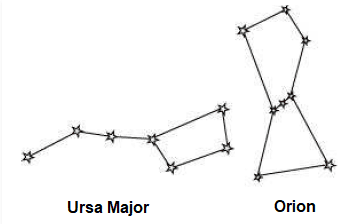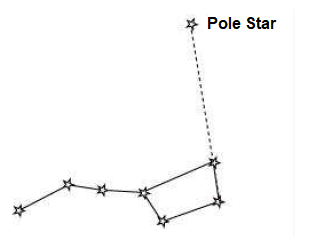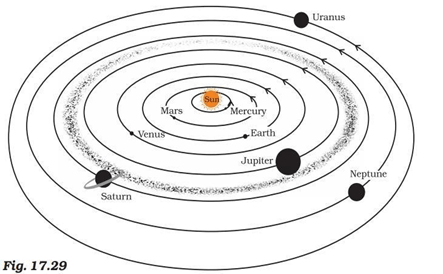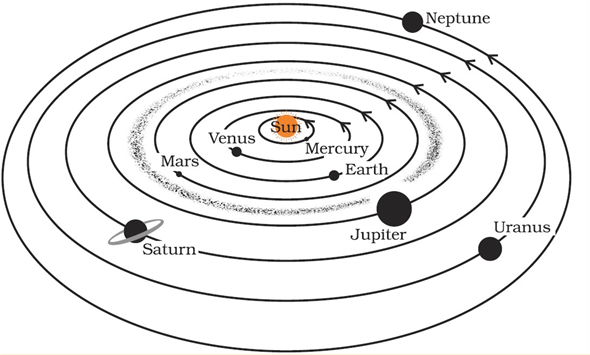NCERT Solutions for Class 8 Science Chapter 17 Stars and the Solar System
NCERT Solutions for Class 8 Science Chapter 17 Stars and the Solar System are given below. Here we have provided the best and error-free answers to all the exercise questions that will strengthen your foundation in science. Solving NCERT questions will assist you in grasping the content in the Crop Production and Management chapter in a better way.
In these solutions, we have answered all the intext and exercise questions provided in NCERT class 8 science textbook. NCERT Solutions for Class 8 Science Chapter 17 Stars and the Solar System provided in this article are strictly based on the CBSE syllabus and curriculum. Students can easily download these solutions in PDF format for free or can read them online.
Stars and the Solar System Class 8 Science NCERT Solutions
Exercise Questions
Question 1: Which of the following is NOT a member of the solar system?
(a) An asteroid
(b) A satellite
(c) A constellation
(d) A comet
Answer: (c) Constellation
A constellation is not a member of the solar system. Constellations are groups of stars that form recognisable shapes.
Question 2: Which of the following is NOT a planet of the sun?
(a) Sirius
(b) Mercury
(c) Saturn
(d) Earth
Answer: (a) Sirius
Sirius is a star and not a planet of the sun.
Question 3: Phases of the moon occur because
(a) we can see only that part of the moon which reflects light towards us.
(b) our distance from the moon keeps changing.
(c) the shadow of the Earth covers only a part of the moon’s surface.
(d) the thickness of the moon’s atmosphere is not constant.
Answer: (a) we can see only that part of the moon which reflects light towards us.
Moon does not produce its own light. We are able to see the moon because the sunlight falling on it gets reflected towards us. Thus, we see only that part of the moon from which the light of the sun gets reflected towards us.
Question 4: Fill in the blanks:
(a) The planet which is farthest from the Sun is ____________ .
(b) The planet which appears reddish in colour is ____________ .
(c) A group of stars that appear to form a pattern in the sky is known as a ____________ .
(d) A celestial body that revolves around a planet is known as __________.
(e) Shooting stars are actually not ____________.
(f) Asteroids are found between the orbits of _________ and _________ .
Answer:
(a) The planet which is farthest from the Sun is Neptune.
(b) The planet which appears reddish in colour is Mars.
(c) A group of stars that appear to form a pattern in the sky is known as a Constellation.
(d) A celestial body that revolves around a planet is known as satellite.
(e) Shooting stars are actually not stars.
(f) Asteroids are found between the orbits of Mars and Jupiter .
Question 5. Mark the following statements as true (T) or false (F).
(a) Pole star is a member of the solar system. ( )
(b) Mercury is the smallest planet of the solar system. ( )
(c) Uranus is the farthest planet in the solar system. ( )
(d) INSAT is an artificial satellite. ( )
(e) There are nine planets in the solar system. ( )
(f) Constellation Orion can be seen only with a telescope. ( )
Answer:
(a) False
Stars are not a member of the solar system. The sun and the celestial bodies revolving around it form the solar system.
(b) True
Mercury is the smallest planet of the solar system.
(c) False
Neptune is the farthest planet in the solar system.
(d) True
INSAT is an artificial satellite.
(e) False
There are eight planets in the solar system.
They are Mercury, Venus, Earth, Mars, Jupiter, Saturn, Uranus and Neptune.
(f) False
Constellation Orion can be seen during winters around late evenings. It is one of the most magnificent constellations in the sky, visible to the naked eyes.
Question 6. Match items in column A with one or more items in column B.
| A | B |
| (i) Inner planets | (a) Saturn |
| (ii) Outer planets | (b) Pole star |
| (iii) Constellation | (c) Great Bear |
| (iv) Satellite of the Earth | (d) Moon |
| (e) Earth | |
| (f) Orion | |
| (g) Mars |
Answer:
| A | B |
| (i) Inner planets | (g) Mars, (e) Earth |
| (ii) Outer planets | (a) Saturn |
| (iii) Constellation | (c) Great Bear, Orion |
| (iv) Satellite of the Earth | (d) Moon |
Question 7: In which part of the sky can you find Venus if it is visible as an evening star?
Answer: Venus becomes visible after sunset that is why it is called evening star. It appears on the western horizon.
Question 8: Name the largest planet of the solar system.
Answer 8: Jupiter is the largest planet in the solar system. It is so large that about 1300 piles of earth can be placed inside this giant planet. However, the mass of Jupiter is about 318 times that of our Earth.
Question 9: What is a constellation? Name any two constellations.
Answer: The stars forming a group that has a recognisable shape is called a constellation.
Two constellations are; Ursa Major and Orion
Question 10: Draw sketches to show the relative positions of prominent stars in
(a) Ursa Major and (b) Orion
Answer:

Question 11: Name two objects other than planets which are members of the solar system.
Answer: Comets, Asteroids and Meteors.
Question 12: Explain how you can locate the Pole Star with the help of Ursa Major.
Answer: Pole star can be located with the help of two stars at the end of Ursa Major. Imagine a straight line passing through these stars. Extend the imaginary line in North direction. This line is about five times the distance between two stars. A star is seen in this direction which is called Pole star.

Question 13: Do all the stars in the sky move? Explain.
Answer: All the stars move in the sky from east to west. Earth rotates about its axis and the pole star, which is situated in the direction of the earth’s axis. It does not appear to move.
Question 14: Why is the distance between stars expressed in light years? What do you understand by the statement that a star is eight light-years away from the Earth?
Answer: Stars are at a distance of millions of kilometres from the earth. Thus, these large distances are expressed in light years. One light year is the distance travelled by light in one year. One light year is equal to 9.46 × 1012 km.
If a star is eight light years away from the Earth. It means that the time taken by light to travel in eight years. So, the distance between the star and the Earth is given by 8 × (9.46 × 1012)km = 7.6 × 1013 km.
Question 15: The radius of Jupiter is 11 times the radius of the Earth. Calculate the ratio of the volumes of Jupiter and the Earth. How many Earths can Jupiter accommodate?
Answer: Let the radius of the Earth be R, so the radius of Jupiter be 11R.

Since, the ratio of volumes is 1331:1, so Jupiter can accommodate 1331 Earths.
Question 16: Boojho made the following sketch (Fig. 17.29) of the solar system. Is the sketch correct? If not, correct it.

Answer: Positions of Mars & Venus and Uranus & Neptune should be interchanged. The correct positions of the planets are as follows:

NCERT Solutions for Class 8 Science Chapter 17 – A Brief Discussion
CBSE Class 8 Science NCERT Solutions Chapter 17 helps students to clear their doubts and to score good marks in the board exam. All the questions are solved by experts with a detailed explanation that will help students complete their assignments & homework. Having a good grasp over CBSE NCERT Solutions for Class 8 Science will further help the students in their preparation for board exams and other competitive exams such as NTSE, Olympiad, etc.